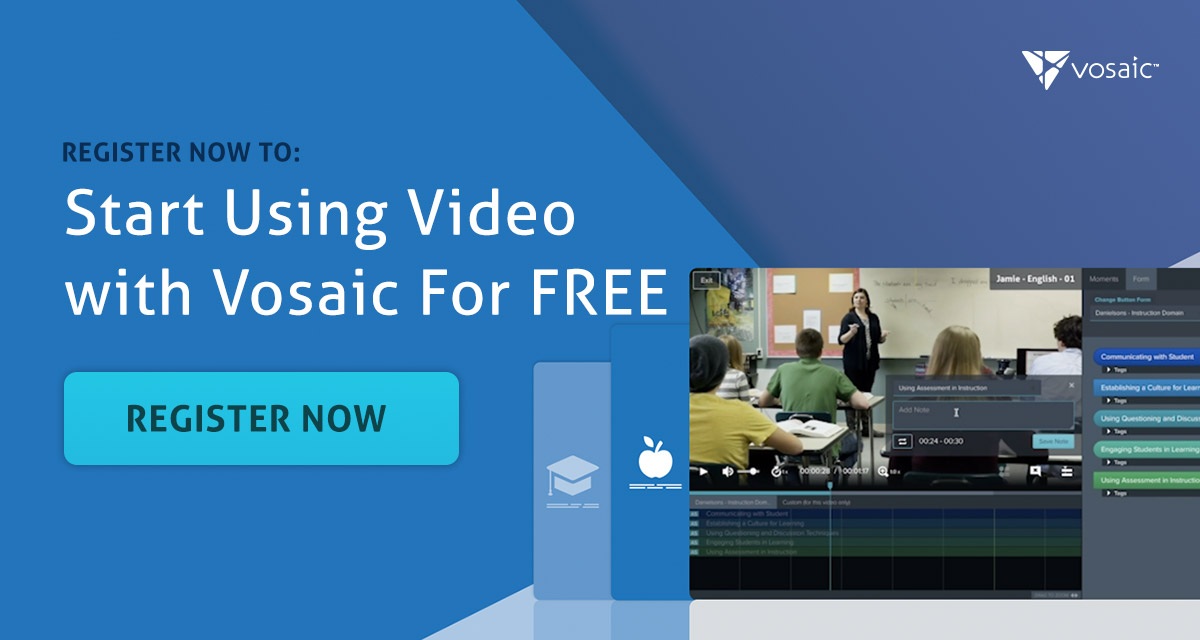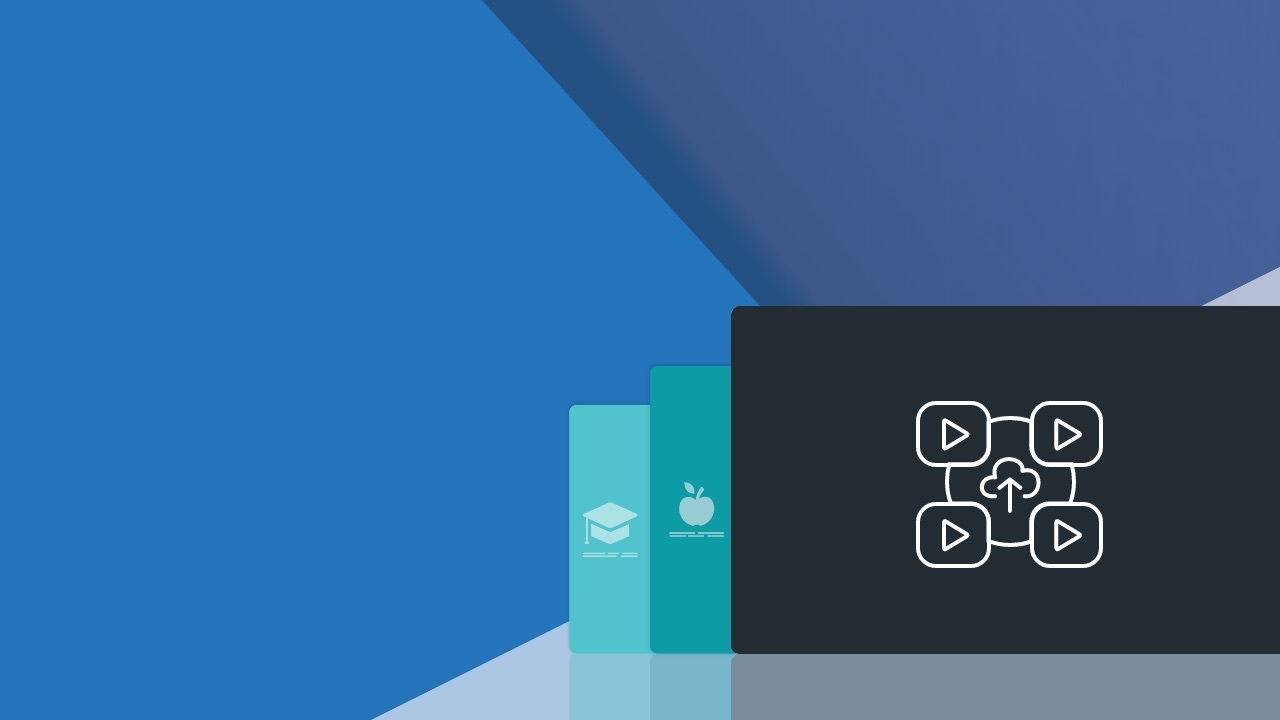Despite advances in modern technology, the classroom experience has been relatively consistent for decades. But thanks to organizations such as the International Society for Technology in Education (ISTE) we’re seeing a push towards better technological integration in the classroom.
ISTE sets the standard for the use of technology in teaching and learning. Naturally, educational platforms seek ISTE’s guidance to ethically and efficiently operate with the usage of technology. These guidelines include a 7-point list of standards that set a precedent for educational institutions aiming to integrate technology into the classroom. Each point is a culmination of different components, many of which can be achieved with the help of Vosaic’s video platform for teacher coaching and professional development.
7-Point Standards for Educators
1. Learner
“Educators continually improve their practice by learning from and with others and exploring proven and promising practices that leverage technology to improve student learning.”
They say you never stop learning, and teachers are no different. ISTE breaks down Learner into three components.
- “Set professional learning goals to explore and apply pedagogical approaches made possible by technology and reflect on their effectiveness.”
- “Pursue professional interests by creating and actively participating in local and global learning networks.”
- “Stay current with research that supports improved student learning outcomes, including findings from the learning sciences.”
All of these components resonate with prevalent research in the field of educator growth and will lead to more transformative classroom practices even beyond the area of technology.
2. Leader
“Educators seek out opportunities for leadership to support student empowerment and success and to improve teaching and learning.”
Students likely have used technology outside of the classroom, not all educators take advantage of this familiarity. Technology can help students reach their full potential through constructive role models. ISTE breaks Leader down into three components.
- “Shape, advance and accelerate a shared vision for empowered learning with technology by engaging with education stakeholders.”
- “Advocate for equitable access to educational technology, digital content and learning opportunities to meet the diverse needs of all students.”
- “Model for colleagues the identification, exploration, evaluation, curation and adoption of new digital resources and tools for learning.”
While students’ access to technology in the classroom varies, it’s undeniably the way of the future. Leadership in a single class can spread through the sharing of best practices, active engagement as a role model, and constant exploration of new opportunities.
3. Citizen
“Educators inspire students to positively contribute to and responsibly participate in the digital world.”
The digital world is still the real world, filled with real people that are affected by your actions. It’s easy to disconnect from or put too much trust into those met online. ISTE breaks Citizenship down into four components:
- “Create experiences for learners to make positive, socially responsible contributions and exhibit empathetic behavior online that build relationships and community.”
- “Establish a learning culture that promotes curiosity and critical examination of online resources and fosters digital literacy and media fluency.”
- “Mentor students in safe, legal and ethical practices with digital tools and the protection of intellectual rights and property.”
- “Model and promote management of personal data and digital identity and protect student data privacy.”
Without adequate education in citizenship, students can find themselves in unhealthy or even dangerous situations online. In addition to specific examples of internet guidelines and these points as guiding principles, educators can help ensure students have a safe and productive relationship with the internet.
4. Collaborator

“Educators dedicate time to collaborate with both colleagues and students to improve practice, discover and share resources and ideas, and solve problems.”
Teachers are accustomed to giving feedback to students, but communication should also be two-directional. Setting aside time to welcome student feedback and share best practices with colleagues can open educators to new perspectives and opportunities they may have overlooked with new technologies. ISTE breaks Collaborator down into four components:
- “Dedicate planning time to collaborate with colleagues to create authentic learning experiences that leverage technology.”
- “Collaborate and co-learn with students to discover and use new digital resources and diagnose and troubleshoot technology issues.”
- “Use collaborative tools to expand students' authentic, real-world learning experiences by engaging virtually with experts, teams and students, locally and globally.”
- “Demonstrate cultural competency when communicating with students, parents, and colleagues and interact with them as co-collaborators in student learning.”
Students’ attention for methodical, lecture heavy teaching is waning. Providing memorable, and real-world applications of the lessons with supplements through experts, local events, and fellow students are all possible through technology.
5. Designer

“Educators design authentic, learner-driven activities and environments that recognize and accommodate learner variability.”
Every student is different, not just in their familiarity with technology but also in their educational needs and individual strengths. Adapting classroom experiences to individual students can empower them to reach their full potential. ISTE breaks Designer down into three components:
- “Use technology to create, adapt and personalize learning experiences that foster independent learning and accommodate learner differences and needs.”
- “Design authentic learning activities that align with content area standards and use digital tools and resources to maximize active, deep learning.”
- “Explore and apply instructional design principles to create innovative digital learning environments that engage and support learning.”
Tools available to the modern classroom have enabled a greater collaboration of educators around individual students. Both in the creation of exercises, assignments, and feedback on student’s performance, video feedback through tools like Vosaic can help teachers individualize the experience for students. Moment to moment comments can help students tie what they did each moment with feedback.
6. Facilitator
“Educators facilitate learning with technology to support student achievement of the ISTE Standards for Students.”
Students have a great deal of influence on the outcomes of their education. ISTE recognizes this with the ISTE standards for students, which like these for educators focus on the productive inclusion of technology in learning. ISTE breaks Facilitator down into four components:
- “Foster a culture where students take ownership of their learning goals and outcomes in both independent and group settings.”
- “Manage the use of technology and student learning strategies in digital platforms, virtual environments, hands-on makerspaces or in the field.”
- “Create learning opportunities that challenge students to use a design process and computational thinking to innovate and solve problems.”
- “Model and nurture creativity and creative expression to communicate ideas, knowledge or connections.”
Active learning is more integral to education than ever Students can take their own experiences further with tech tools increasingly available in the classroom. Various studies, such as this one conducted at the University of Washington, exemplify the utility of student use of technology for collaborative learning and teacher-student interaction.
7. Analyst
“Educators understand and use data to drive their instruction and support students in achieving their learning goals.”
With a similar focus on student empowerment in technology integration, ISTE promotes teachers in allowing students to demonstrate their learning in ways that work for them. Everyone’s abilities, communication style, and interests manifest differently. ISTE breaks Analyst down into three components:
- “Provide alternative ways for students to demonstrate competency and reflect on their learning using technology.”
- “Use technology to design and implement a variety of formative and summative assessments that accommodate learner needs, provide timely feedback to students and inform instruction.”
- “Use assessment data to guide progress and communicate with students, parents and education stakeholders to build student self-direction.”
There are many ways teachers could approach the Analyst point of the ISTE standards, and the other six likewise. One tool that is designed to help empower teachers to analyze their own practices, provide in-depth feedback to students, and allow for greater learning flexibility is Vosaic.
How Vosaic Can Help
In the post-COVID classroom, technology is a growing consideration that has gone from an additive extra to an essential tool for educators to connect with students in a meaningful way. This is resulting in increased investment and reconsideration of how funding is allocated to technology in the education system as a whole. As of mid-2020, less than 5% of the $1.6T spent on education in the US each year is on technology integration. A share that is more than likely to grow as more educators and districts see the necessity for edtech. Not only to improve student learning but also to improve teacher coaching and professional development.
At Vosaic, our goal is to make video technology accessible and easy to use so that schools can focus their professional development on what matters the most: student achievement. There are many instances in which Vosaic’s technology highlights and promotes ISTE’s set of standards and helps teachers find better ways to leverage technology in their own professional development. Educators looking to adopt such standards could utilize Vosaic to become a Learner, Leader, Citizen, Collaborator, Designer, Facilitator, and Analyst that every education platform strives to be.
Video in education is quintessential to a full understanding of performance in the classroom. With ISTE Standards paving the way, Vosaic leads in creating an authentic, honest, and progressive teacher coaching experience. Learn more about how Vosaic helps supplement and improve professional development efforts you already have in place at your school or district.




